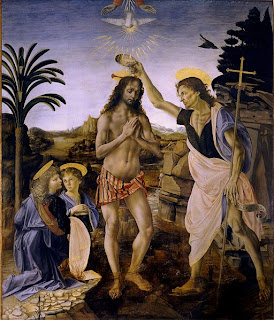 |
| Baptism of Christ, photo courtesy of Wikipedia CC |
Leonardo da Vinci, who lived from
1452-1529, became one of the most celebrated artists of his time. According to Giorgio Vasari, from
childhood da Vinci easily mastered every subject he sought to learn, though he
often grew bored before moving on to another. Most well known for painting, da Vinci tired of or grew
frustrated of many projects, as with the subjects he abandoned, and became most
well known for rarely finishing a commission. Vasari writes that da Vinci’s “understanding of art [caused him to begin] many projects but never finish any…feeling that his hand could not reach artistic perfection in the works he conceived, since he envisioned such subtle, marvelous, and difficult problems that his hands, while extremely skillful, were incapable of ever realizing them”(pg 287, The Lives of Artists). It is for this reason that da Vinci was the first artist of
the Renaissance to alter the traditional power of patron over artist, in turn
for artists’ power over patrons.
 |
| Madonna of the Rocks, photo courtesy of Wikipedia CC |
During his youth da Vinci painted
in the workshop of Andrea del Verrocchio.
At the time, Verrocchio worked on a painting of Saint John baptizing
Christ, and though da Vinci only painted a small angel carrying garments, the
figure stands out so superbly that according to Vasari “this was the reason why
Andrea would never touch colors again”(287). This is a notable point, most poignant when the painting,
The Baptism of Christ (1475) is viewed in
person because da Vinci's work with color here is far superior when compared to the entire painting. Even as a young man da
Vinci’s keen eye for observation added so much to his skill with painting that
he was able to create images like none before. His eye for observation is obvious when any one of his
paintings is compared to one of his contemporaries. When others painted hazy mountains in the distance, da Vinci
created realistic atmospheric perspective. Sfumato in paintings such as Madonna of the Rocks (1480) and Mona
Lisa (1503-1505) adds a tonal mysterious and emotional impact.
 |
| Mona Lisa, photo courtesy of Wikipedia CC |
Da Vinci was, however, not only a
forrunner of advancing painting; he was also one of the first men to study
correct human anatomy extensively.
Creating a book filled with drawings of cadavers and dissections of his
own hand, he sketched the inner workings of the human body so as to accurately
understand it. He also filled
notebooks with drawings of inventions far beyond his time – so far beyond that
there was no technology to keep up with his ideas.
Ultimately, Leonardo da Vinci was a conceptual genius, loved in his time and in the modern world. Best known in his day for advancing the art of painting, he has also never been truly surpassed in this art. However, more like the modern artist, da Vinci was more concerned with the concept of his art than the presentation, and when carried out his perfectionism caused him frustration and grief.
No comments:
Post a Comment